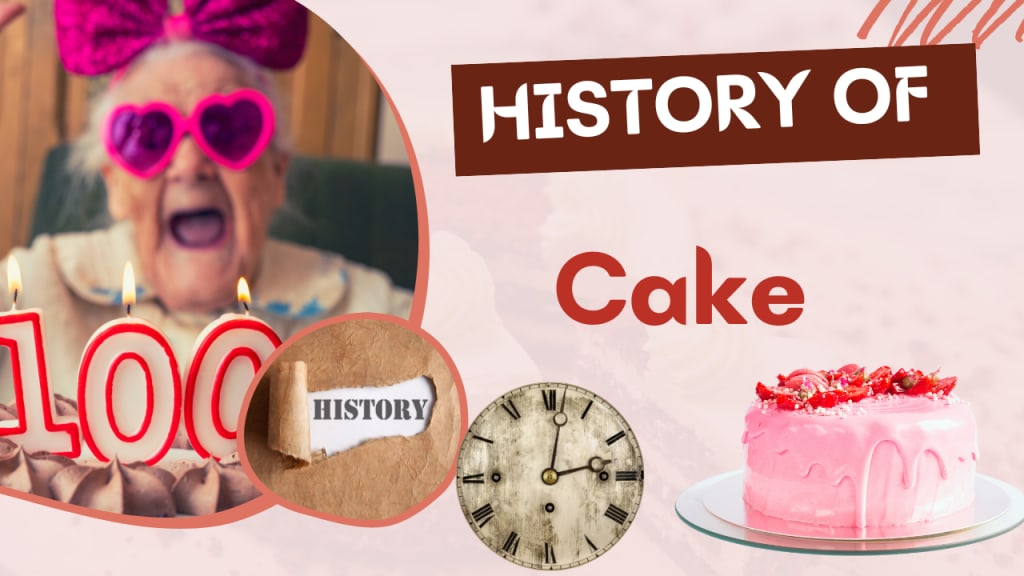The History of Cake
Interesting Facts About Cake You Didn't Know

As we know that many of us enjoy our memorable events by incorporating cakes. These events are birthdays and weddings. Even at home, when we crave a delectable and sugary treat, cake often comes to mind. But have you ever wondered how this beloved confection came into existence? The fascinating history of cake is woven with diverse traditions and symbolic meanings from various cultures and nations. Together, they have shaped the delightful cakes we enjoy today.
Food historians suggest that the ancient Egyptians were the first to display baking skills and interest. Tired of game meat, they wanted something different. They made bread-like treats sweetened with honey instead of sugar. The word "cake" comes from the Vikings, specifically the Norse word "kaka."
Cakes carry a special meaning because they represent the importance of the person they are intended for. Back in the old days, ingredients like refined sugar, nuts, and dried fruits were expensive, making the cake a valuable gift. Although these ingredients are more affordable now, the sentiment remains. Giving someone a cake is a simple yet meaningful way to show that you care.
Who Named Cakes?
Do you know that cakes have a deep history that can be found in ancient times? Desserts in those days were often sweetened bread. As time passed, the cake recipe transformed to include more sugar and sweet ingredients, leading to the creation of the modern cake we enjoy today.
Cakes hold great significance in various cultures and celebrations worldwide. For instance, in the United Kingdom, people relish "tea cakes" as a popular snack or breakfast item, while in Japan, traditional "castella" cakes are savored as desserts.
The term "cake" has Viking origins, originating from the Old Norse word "kaka". In ancient Greece, cakes were referred to as "plakous", derived from the word "plakoeis" meaning "flat". These types of cakes are having various basic ingredients like a mixture of flour, eggs, milk, nuts, and honey.
History of Cake – Are They Part Of Ancient Rituals
Cakes have long been intertwined with ancient beliefs and superstitions, with some customs still observed today. In ancient times, people offered cakes to their gods and spirits worldwide. For instance, during the Chinese Harvest Moon Festival, moon cakes are shared to honor the moon goddess. In addition, this tradition is also famous till the day today.
Russians pay respect to a deity named Maslenitsa by enjoying sun cakes called blini, which are thin pancakes. Similarly, ancient Celts rolled cakes down hills during the Beltane festival to imitate the movement of the sun as spring arrived. So having a rich and deep history of cake, they make our events so memorable and loving. Many bakers generate revenue by running cake businesses. They also use custom cake boxes to meet their packaging needs.
Explanation of Cakes Having A Circular Shape?
While nowadays we can find cakes in various shapes, like hearts, cartoons, animals, castles, and even more explicit designs if one prefers, traditionally cakes were round. This round shape represents the cycle of life, the sun, and the moon. It's probably why cakes are present at important events, symbolizing the start of a new phase in our lives.
In ancient times, breads were also round, often made into balls and baked in shallow pans. During the 17th century, cake hoops made of metal or wood started to gain popularity.
More From Author : History of Pizza
When Did Cakes Get Easier To Make?
The Industrial Revolution brought about baking soda and baking powder, making it easier for people to bake cakes. This convenience increased their popularity, especially among the masses. Ovens with better temperature control meant that cakes could be baked without constant supervision. In addition, the introduction of railroads made ingredients more accessible and affordable for everyone.
Types of Cakes
Cakes can be sorted into different groups by professional bakers based on ingredients and mixing methods. This helps in understanding how to make a cake effectively. Meanwhile, home bakers tend to categorize cakes by flavors like chocolate or fruit, which is helpful for deciding what to eat. However, for understanding cake preparation, the ingredient and mixing method categories are more informative. Further, every cake has a different taste and texture which is depend upon how the batter is prepared.
1. Butter Cake
You can easily transform this delightful buttermilk-raspberry butter cake into various forms such as a layer cake, sheet cake, or even a DIY wedding cake. When a cake recipe begins with the step of creaming butter and sugar, it falls under the category of butter cake. Following the creaming process, you incorporate eggs into the batter to create a light and airy texture. Additionally, you add flour (and sometimes another liquid like milk) to provide structure and texture, and baking powder or baking soda to ensure proper rising during baking.
Variations of butter cake include chocolate, white, yellow, and marble. The color of white and yellow cakes often depends on whether they contain whole eggs or extra egg yolks (yellow cake) or solely egg whites (white cake).
2. Pound Cake
Pound cake is a close relative of butter cake. Did you know why this type of cake has been named as “pound cake”? it is because this cake has been made with an equal portion of its ingredients. Like a pound of butter, a pound of eggs, a pound of sugar, and a pound of flour. Some pound cake recipes call for separating the eggs and whipping the egg whites before folding them into the batter to make it lighter.
Other recipes use leavening agents like baking soda and baking powder, which place them firmly in the category of butter cakes. These cakes are typically delicately flavored and can be enjoyed plain or with a simple glaze or water icing on top. Pound cakes are commonly baked in a loaf or Bundt pans. Many coffee cakes, sour cream cakes, and fruit crumb cakes are variations inspired by the classic pound cake.
3. Angels Food Cake
Angel food cake got its name because of its white color and light, fluffy texture. The airy texture comes from using egg whites, and it's supposed to represent angels. But along with angels, there are also devil cakes. Devil cakes became popular in the 20th century. They got their name because they taste so rich and delicious, they feel a little sinful. Even today, some people think of chocolate as a bit sinful because they worry about its impact on their waistline.
The bottom line, cakes are very loving and enjoyable delights in our special events. We enjoy our happiest moments by eating sweet cakes. So the history of cake continues to grow and more people are loving it.
About the Creator
lary michael
I am an expert in the bakery business with over 15 years of experience in the industry. I have a passion for creating delicious treats and running a successful bakery led her to become a sought-after consultant and speaker in the field.






Comments
There are no comments for this story
Be the first to respond and start the conversation.